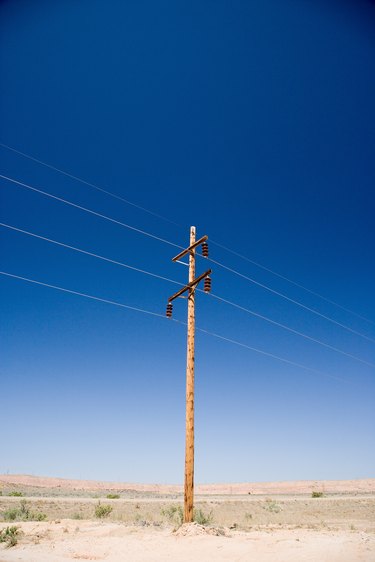Things You'll Need
25-foot-long retractable tape measure
Pen
Paper
Plants

Looking out your back window or patio doors, you want a pleasant view of plants and the surrounding terrain. Utility poles may bring modern conveniences to the neighborhood, but they certainly can look ugly and detract from otherwise fantastic vistas. Hiding the stark, barren vertical poles is somewhat challenging, as it requires landscape design planning, time and a budget to purchase large-sized plant materials. Safety and code-enforcement issues also must be considered.
Step 1
Contact your local government and utility company to learn about any code or maintenance standards regarding the electrical posts. Ask about the distance requirements regarding the planting of trees near the posts. A municipality may have codes that limit what tree species or mature plant heights are acceptable to plant. The utility company can tell you how close a branch or plant may be to the pole before its maintenance crews prune it to protect their utility pole and wire property. Write down these requirements.
Video of the Day
Step 2
Look out to the electrical pole from every window and primary activity area in the back yard, including the patio or picnic area. Note where the view of the electrical pole is most offensive so you'll know where you need to landscape to improve your backyard experience.
Step 3
Recruit a family member or friend to act as a model to gauge where a screening tree would be most effective in blocking the view of the electrical pole from several vantage points. Give him the retractable tape measure. While standing at the house or patio, send the person to stand at the back of your property line, representing the trunk of the potential tree. Have him move as needed to get a sense of where the tree would need to be to block the electrical pole from most, if not all, of the primary vantage points you are looking from. Use the tape measure to pinpoint locations, or to help you visualize the width of a tree's branch canopy needed for the best screening effect, and record these locations.
Step 4
Write down any figures regarding how wide the plant must be for good screening, combining these with the code requirements regarding acceptable heights and tree species you obtained earlier. These notes and numbers will help you choose from the numerous plants available at a nursery. Remember to consider the plant's mature size, growth rates and any ornamental features along with its screening ability.
Step 5
Visit the local plant nursery and look for evergreen plants that will potentially block the view of the electrical post. Avoid deciduous plants unless you don't mind seeing the utility post in winter months. Either a singular large tree -- or a tree that will grow and mature to an appropriate size -- or multiple narrow, upright shrubs or trees may be used to create a visual screen to block the view of the electrical post.
Step 6
Plant the trees an appropriate distance from the electrical pole on your property, as advised by local code, the utility company or the nursery. Do not buy a tree that grows so fast or large that constant pruning maintenance is needed, causing the tree to become a nuisance or financial burden.
Tip
Narrow-habit shrubs or trees, sometimes described as being fastigiate or columnar by horticulturists, are best to block vertical electrical posts. Upright arborvitae, for example, focus their growth vertically, blocking your view of a pole without taking away too much horizontal space in the backyard.
If you are certain you want a specific tree species or a certain size, talk to the nursery staff. It's likely they can contact their wholesale grower to obtain a tree or shrub that is already large or at a price to suit your budget.
Warning
Do not plant vines under the pole to climb up and mask it. Such plants are killed with chemical herbicides or constantly pruned off to keep utility poles clean by the maintenance crews. Always plant screening plants on your property -- not on others' private property or in a public right-of-way.
Larger trees or shrubs cost much more than those that are younger and smaller. Although planting a larger shrub or tree instantly blocks the view of the electrical pole, more cost is incurred in purchase, transportation and planting labor on bigger plants, especially those with massive, heavy root balls. Larger plants require more watering and care to ensure their roots reestablish more thoroughly the first two to three years after planting. There is more risk of winds toppling a large plant, or the effects of drought causing dieback on larger plants with limited root systems.
Video of the Day